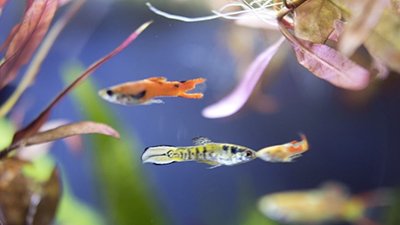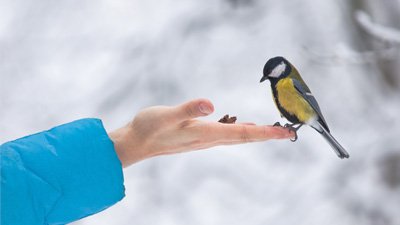
Vipers’ Reproduction Like Virgin Birth at First Glance
Sperm, or no sperm? That was the question.
News Source
- LiveScience: “Virgin Birth Discovered in Pit Vipers”
When both a copperhead and an eastern diamond-back rattlesnake gave birth after five years of celibacy, Warren Booth, and Gordon Schuett decided to do some DNA detective work. Their surprising findings, published in the Biological Journal of the Linnean Society, reveal some sneaky reproductive strategies.
Each snake had been in captivity for five years with no opportunity to mate. Both were juveniles when captured. By analyzing the DNA of the snakes and their offspring, the researchers discovered the two snakes had reproduced using entirely different strategies.
DNA analysis of the rattlesnake and her offspring demonstrated sperm were involved in their conception.
The researchers report that this is “the first genetically confirmed case of long-term sperm storage (LTSS) of exceptional duration (5 years) in the eastern diamond-backed rattlesnake.”1
The copperhead offspring, however, had no DNA evidence of genetic input from a father. Thus, the copperhead had reproduced using parthenogenesis. Parthenogenesis is self-cloning. Organisms able to clone themselves are common among plants and invertebrates, and more than 80 have been discovered among fish, amphibians, and reptiles.2 Parthenogenesis has been observed in the komodo dragon, sharks, turkeys,3 and a boa constrictor.
The pit vipers are apparently “particularly well-adapted to insuring the production of offspring when conditions may be adverse.”
“Mating opportunities may be rare in many species,” Booth said. It therefore makes sense “for a species to have solved this problem through the evolution of mechanisms by which mating can occur when the opportunity arises and the spermatozoa stored until needed. . . . Instead of wasting eggs, which are costly to produce and a finite resource, parthenogenesis may represent an alternate means of reproduction to overcome this.” The pit vipers are apparently “particularly well-adapted to insuring the production of offspring when conditions may be adverse.” Furthermore, “With the availability of DNA fingerprinting technologies, we are now becoming aware that the process of parthenogenesis is in fact more common than we ever imagined.”
The researchers write, “In light of these recent findings it appears that parthenogenesis may, in fact, be an important aspect of vertebrate evolution and not the evolutionary novelty it was once considered.” Facultative parthenogenesis (FP, the ability to self-clone as an option) has never been “documented in naturally occurring populations; thus, the evolutionary significance of FP will not be fully realized until reproductive competence can be demonstrated under natural conditions. Presumably in nature, . . . parthenogenesis would represent an evolutionary mechanism promoting population establishment and survival when females become isolated from mates. . . . To understand the circumstances in which FP might be adaptive, we need to know how often a female is in a situation where the small reproductive benefit” would outweigh the loss of genetic diversity.4
Because cloning reduces genetic diversity, many have viewed it as an evolutionary dead end. Given the prevalence of this mode of reproduction, however, both evolutionists and creationists see this reproductive option as a useful adaptation to adverse conditions where survival of a species is a more pressing need than maintenance of genetic variability. Yet nothing evolutionary has been demonstrated here. No new kinds of creatures were being produced. Instead, existing species simply revealed an arsenal of reproductive options to facilitate survival.
God evidently created certain creatures with the ability to reproduce in the absence of males. This ability would keep their populations alive during unfavorable times. Although no mechanism for making the switch to cloning is demonstrated in this study, a mechanism by which cloning ability is enabled has been elucidated in a salamander population.
Biblically it is easy to understand that God would equip the creatures He made with a variety of strategies to maintain their populations while they reproduce after their kinds.
Further Reading
For More Information: Get Answers
Remember, if you see a news story that might merit some attention, let us know about it! (Note: if the story originates from the Associated Press, FOX News, MSNBC, the New York Times, or another major national media outlet, we will most likely have already heard about it.) And thanks to all of our readers who have submitted great news tips to us. If you didn’t catch all the latest News to Know, why not take a look to see what you’ve missed?
(Please note that links will take you directly to the source. Answers in Genesis is not responsible for content on the websites to which we refer. For more information, please see our Privacy Policy.)
Footnotes
- B. Yirka, “New Research Offers Insight into Long Term Sperm Storage in Animals and Parthenogenesis,” Phys.org, October 17, 2010, http://www.physorg.com/news/2011-10-insight-term-sperm-storage-animals.html.
- W. B. Neaves and P. Baumann, “Unisexual Reproduction Among Vertebrates,” Trends in Genetics 27, no. 3: 81–88, http://www.cell.com/trends/genetics/abstract/S0168-9525(10)00229-5.
- Yirka, “New Research.”
- Booth, W. and G. Schuett. 2011. Molecular genetic evidence for alternative reproductive strategies in North American pitvipers (Serpentes, Viperidae): long-term sperm storage and facultative parthenogenesis. Biological Journal of the Linnean Society. 104 no. 4:934–942. DOI: 10.1111/j.1095-8312.2011.01782.x

Answers in Genesis is an apologetics ministry, dedicated to helping Christians defend their faith and proclaim the good news of Jesus Christ.
- Customer Service 800.778.3390
- Available Monday–Friday | 9 AM–5 PM ET
- © 2025 Answers in Genesis



